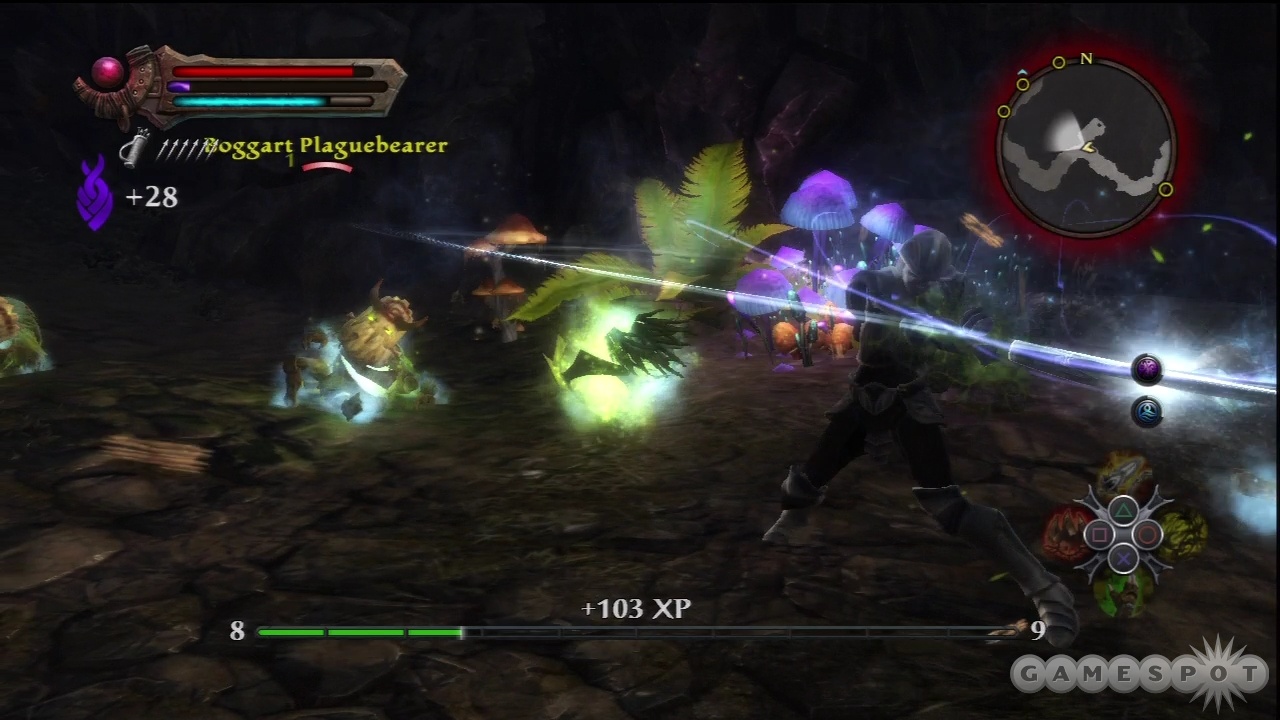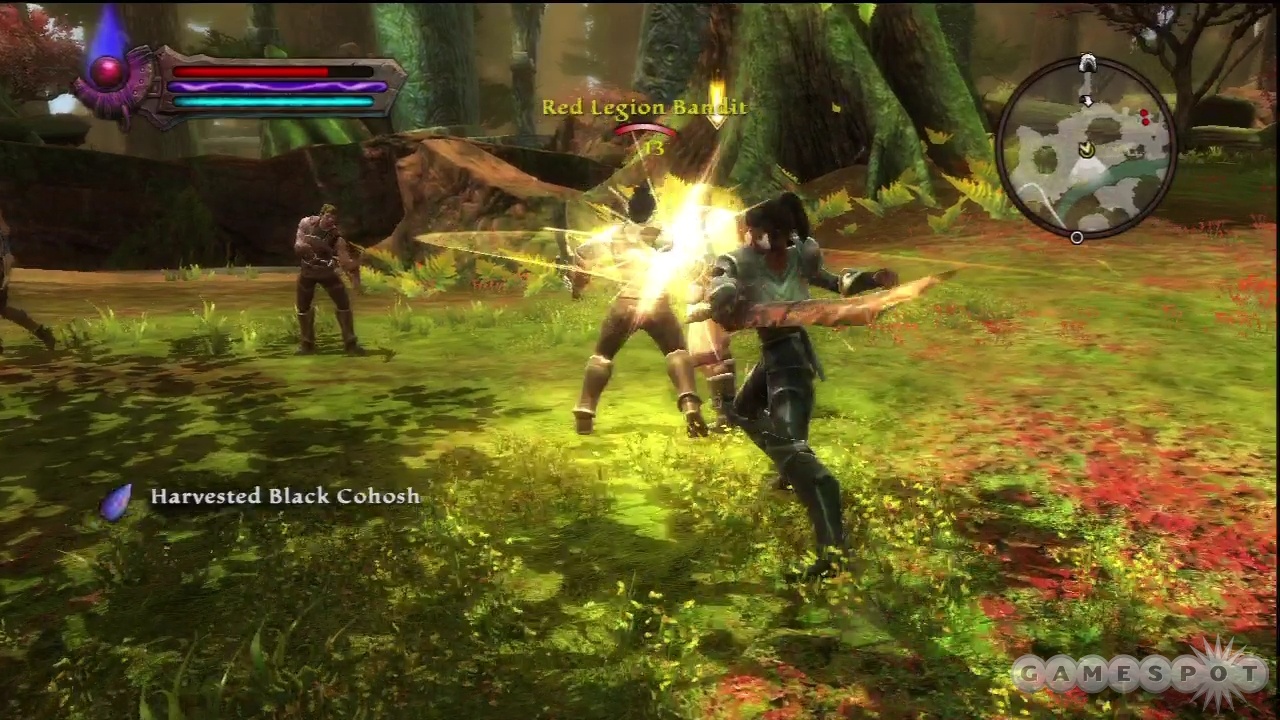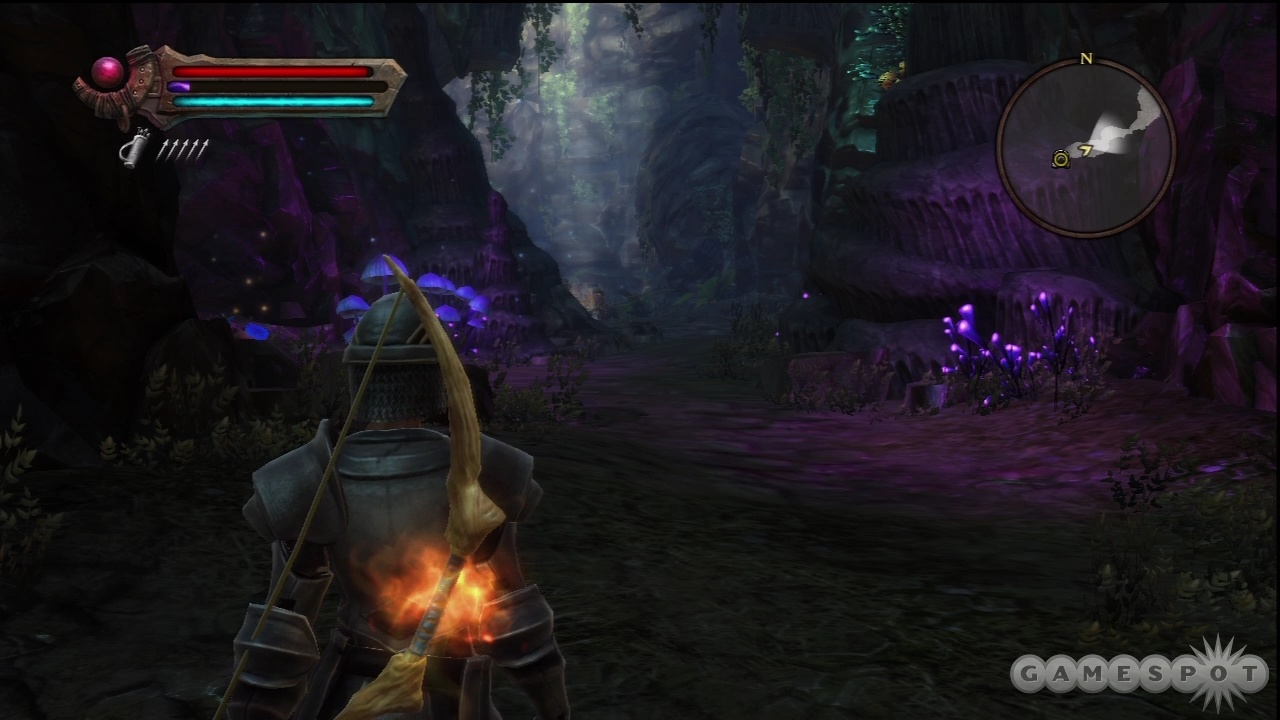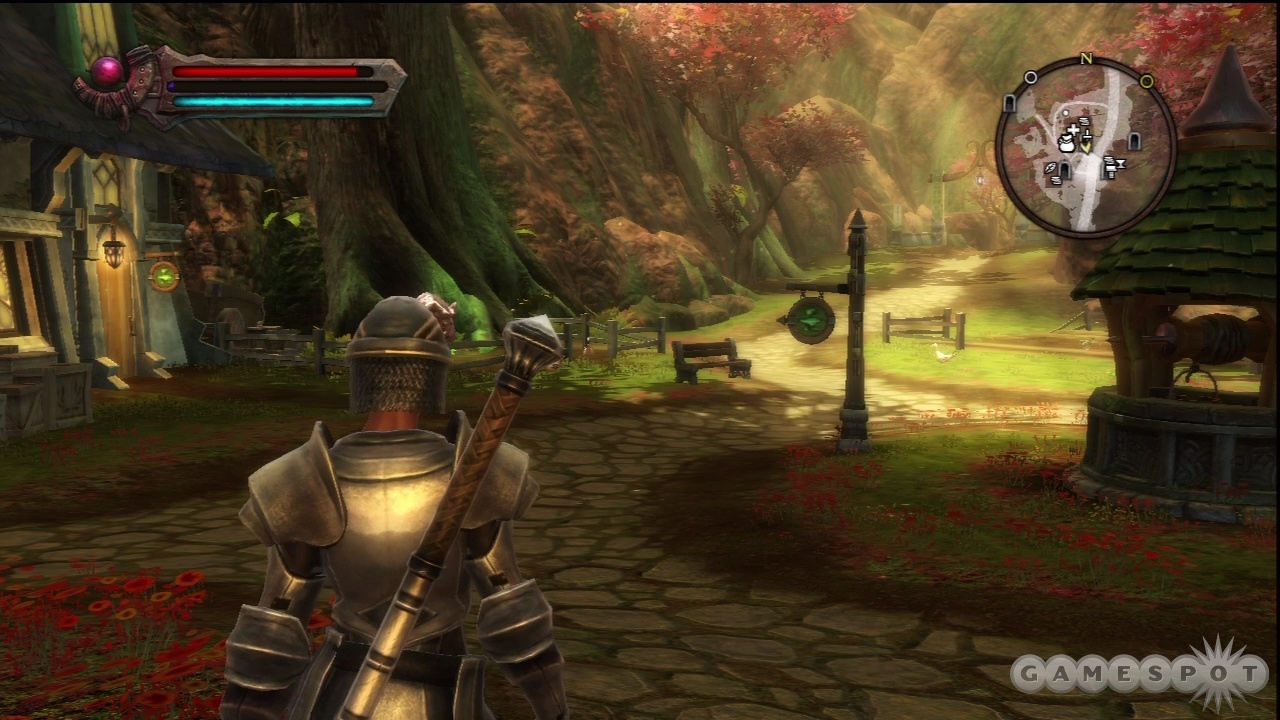Even the greatest role-playing games aren't necessarily known for their great combat. They're frequently praised for their ambitious worlds, their involving stories, and the element of choice. But when you talk about your favorite RPGs, it's not often that the action is what you talk about first.
Kingdoms of Amalur: Reckoning is not like those games. In the future, when you talk about Kingdoms of Amalur, the first thing you will probably mention is how fun the battles were. Incredibly, this RPG's combat is so exciting, it could have been used in a pure action game and would have held up just fine. In fact, from a swordplay, loot, and leveling perspective, Kingdoms of Amalur is as good as any RPG in recent memory. This is the role-playing game you should be playing if excellent action and progression are your primary concern.
Of course, RPGs are about more than just swinging swords. The best of them aren't just games--they're worlds, in which unusual people mill about, inviting you into their homes and telling you of unimaginable treasures protected by unimaginable monsters. It's here that Kingdoms of Amalur falters. Amalur is nice enough to look at, and there are lots of things to do there. But each thing you do is pretty much like the last thing you did. In The Elder Scrolls V: Skyrim, you stumble upon a coven of cannibals and have telepathic conversations with a dog. In Mass Effect 2, you explore the painful past of a troubled young woman and witness the ultimate conflict between mother and daughter. In Kingdoms of Amalur, you kill stuff and listen to a bunch of nondescript characters spout line after line of unexceptional fantasy lore. There's so much talking, so much effort put into all this dialogue. And yet Amalur never develops an identity in spite of it all. There's a lot of tell, but not a whole lot of show.
There's at least a great premise providing a foundation for your adventure. You see, you are dead. Or at least, you were dead before a device called the Well of Souls brought you back to the land of the living. Upon reawakening, you find yourself in quite the position: you no longer have a fate. And because the laws of fate no longer apply to you, you can change destiny as you see fit. Save innocent lives. Kill your enemies. In conversation, act like a jerk--or like an angel. Like other RPGs, Kingdoms of Amalur occasionally grants you the power to choose. However, the story’s very premise nods to the fact that you are a blank slate, free to progress as you see fit. You're special in this world because everyone else is tied to the threads of fate. Before you came along, the future was unchangeable.

It's a pity that Kingdoms of Amalur doesn't know what to do with the setup. You gradually learn more about your self-named, blank-slate character, but the game is more interested in getting you into battle than it is in developing its people. You can talk to the inhabitants about all sorts of things, but doing so is rarely more interesting than reading some dusty tome. It's nice to have a world fleshed out by conversations and books, but in any game, it's better to see and experience an adventure firsthand than it is to hear someone talking about one. There are some nice narrative touches that resonate, such as a conversation with a woman angry that the church has outlawed female clergy. But most dialogue is wooden description.
Many fine RPGs don't feature great central plots or superior dialogue, so the humdrum storytelling may not be a bother for you. It's too bad that the side quests don't pick up the slack. There's so little variety here. Kill spiders, find a missing person, collect these items, and so on. A few of these have a spark of creativity. You partake in a bizarre reenactment of an old legend, speak with a wolf cursed to roam as a human, and assist a dimwit who has been deceived by pranksters pretending to be something they're not. But overall, questing in Kingdoms of Amalur is a game of "chase the waypoint," in which you run toward quest goals without caring about why you're heading there. The dullness of questing is reinforced by your own voiceless character during cutscenes, who mutely stares into space during every conversation as if he or she has heard it all before.

You may have heard Kingdoms of Amalur compared with The Elder Scrolls V: Skyrim, in the sense that they are both open-world fantasy RPGs. But such comparisons aren't really accurate. Amalur is "open-world" in a pedantic sense, yet it's not an enormous landmass, but rather a collection of big areas separated by winding corridors. (All you have to do is open the world map to see how different this game's world structure is from an Elder Scrolls game.) It's more akin to a large-scale Fable, with loading times and winding pathways used to segment explorable areas, dungeons, and towns.
The art design may also remind you of Fable (or maybe World of Warcraft), though Kingdoms of Amalur isn't so self-consciously lighthearted. It is certainly lovely, however, in a vanilla sort of way. Bright red and blue flowers dot sun-dappled meadows, where antelopes graze and hop about, prancing away when you draw too near. Crooked lampposts and skewed wooden rooftops welcome you to a desert village and its brown cobbled streets. It's all so pretty, pixie dust rising from enough grassy knolls and daisy patches that it looks like an army of fairies just exploded. But the visual design lacks identity, embracing the middle of the road and never reaching beyond. Kingdoms of Amalur doesn't have the exaggerated charm of Fable II or the rich detail of The Witcher 2: Assassins of Kings. It happily embraces its pedestrian prettiness, like the front cover of any fantasy novel you might find on a bookstore's shelf.
It's that lack of identity that holds Kingdoms of Amalur back from being a force to be reckoned with. It feels like it was made by separate teams that did their own things without checking in with each other. The dialogue is all so serious, yet the art design doesn't complement that tone with an equally serious look. The creature designs are so wonderfully frivolous they seem like they belong in another game--though on their own, they are the best part of the game's visuals. Sure, you've got some ordinary wolves and spiders. But you've also got kooky boggarts that dance about like miniature witch doctors. Kobolds' ears are so pointed, they look as if they could carve up a roast, and big brutes called ettins are so engorged with muscles that it looks as if their sinewy tendons might rip through their skin at any moment.
Boy is it fun to fight these creatures! Kingdoms of Amalur's combat is fantastic, no doubt about it. Depending on how you equip yourself and how you spend skill points (more on this to come), you might find yourself heaving a long sword in addition to a pair of daggers, or sporting a bow and arrow along with some chakhrams. What are chakhrams, you may ask? Well, they are razor-edged hoops you fling at your enemies, which, like all of the game's weapons, may possess elemental properties to make them even more effective. Flinging a pair of fiery rings about is a blast. And as you level up, you earn moves that make you even more powerful, letting you string moves into combos that have you leaping out of harm's way as you fling the chakhrams forward, or releasing them in a single thrust that sends them circling around you like murderous whirling dervishes.
Chakhrams are by no means the only way to have fun in Kingdoms of Amalur. If you choose a great sword, you juggle enemies and perform combos that have you hurtling about like a champion pole-vaulter. With a late-game magic spell, you combine lightning, fire, and ice attacks in a slow-motion fit of elemental rage. With daggers equipped, you can sneak up on enemies and slit their throats from behind. Of course, there's more to good combat than all these fancy animations and combos. Without basics like proper collision detection or tight controls, the visual flourishes would be meaningless.
Thankfully, the combat is mechanically sound. When dagger meets flesh, you feel the impact. The occasional minor delay aside, the game responds to your button presses properly, allowing you to fire off arrows and spells without trouble. The auto-targeting (usually) chooses the proper target based on the direction you face, letting you move from enemy to enemy in a chain of slashes, stabs, and parries. The only trouble you might encounter is with the camera, which valiantly tries to make the action look cinematic. Every so often, however, it pulls in so close you can't properly manage the battle, or it might park itself underneath the ground geometry.

You occasionally get the chance to enter reckoning mode and activate a melodramatic finishing kill that has you shoving a sword down an ogre's throat, or something equally vicious. (Hysterically, initiating a conversation while still in reckoning mode initiates a conversation with slow-motion lip synching but normal-paced voice-over.) But as satisfying as those fatalities are, the action's flexibility is even more so. You have two weapon slots and can equip anything you want in them, provided you meet the stat and level requirements. You can also spend points in any of three extensive skill trees, roughly divided into spellcaster, rogue, and warrior roles. Go full-on mage if you want, or mix and match as you see fit. Wield a sword and a magical staff. Try for the unlikely combination of scepter and hammer. Don't like how things are shaping up? Visit a fateweaver to reset your entire skill tree and redistribute your points in another way. Such are the benefits of freedom from the confines of fate.
With so much flexibility, looting becomes even more rewarding. Monsters drop a lot of stuff, and you find chests scattered everywhere. Because you could potentially change your approach at the drop of a hat, you might get use out of items that you would consider vendor trash in other games. Heck, you can break down some of that equipment and build your own weapons and armor using the blacksmithing skill. Vendors are there when you need them, but chances are that you can find or make items that are far more useful than what you can buy. You can even name your own creations, so feel free to use four-letter words in the name of your super special staff if you so desire. The game's ESRB rating is M, after all.
Other side activities include alchemy (experiment with herbs and make potions!) and sage crafting (make gems and slot them into your weapons and armor!), though that is hardly all of them. There's simply a lot of game here, and as uninventive as the quests are, there's comfort in going from location to location, engaging in awesome battles and unlocking chests to discover the spoils inside. (Side note: just because a lock is rated as difficult doesn't mean what's inside is all that valuable. It's disappointing to find a few herbs and minor trinkets that you might have found in an unlocked chest.) And there's no questioning how well Kingdoms of Amalur is put together. Bugs are rare, the combat is balanced well, and the frame rate is generally smooth. The only vermin you face are on the field of battle.

How much you love Kingdoms of Amalur: Reckoning depends on what you look for in a role-playing game. Let's say you long for a pervasive sense of time and place, for a great story featuring memorable characters, or for varied quests given weight by superb context. If that's you, then Kingdoms of Amalur will disappoint. Then again, you might want wonderful battles against cool creatures, terrific looting and leveling, and lots of ways to customize your skills and equipment. If so, then this is the world you should inhabit. The context is hardly inspired, but you'll be having so much fun that you may not care.